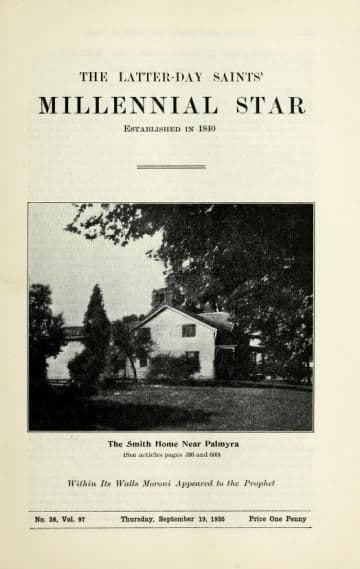Magazine
The Significance of Cumorah

Title
The Significance of Cumorah
Magazine
The Latter Day Saints' Millennial Star
Publication Type
Magazine Article
Year of Publication
1935
Editors
Merrill, Joseph F. (Secondary), Bennett, Richard S. (Secondary), and Ashton, Wendell J. (Secondary)
Pagination
596–597
Date Published
19 Sept. 1935
Volume
97
Issue Number
38
Abstract
This article mentions the erection of the Cumorah Monument, and identifies Moroni as a resurrected Nephite prophet. The author stresses the doctrine of the immortality and resurrection of man.
THE SIGNIFICANCE OF CUMORAH
TO Latter-day Saints everywhere the erection of a monument commemorating the coming forth of the Book of Mormon is an event of overwhelming significance. Undoubtedly the thing connected with the Hill Cumorah in the minds of the saints generally is not the revelation of the Nephite Record, great as that is, but rather the idea that man has a conscious individual immortality, with all that this idea means. The appearance of Moroni to Joseph Smith is a most startling confirmation of the resurrection from the dead as set forth in the New Testament.
Moroni, as the Prophet tells us, lived on the American continent at the close of the fourth and the opening of the fifth century of the Christian Era. He was the descendant of a race that had occupied that land for a thousand years. It was his misfortune to see the almost total extinction of his nation—a white, civilized people. After burying in the Hill Cumorah some metallic plates containing a history of the Lehites, which was an abridgment made by his father Mormon, Moroni died. But, somewhere between the time of his death and his appearing to Joseph Smith, in 1823, he was raised from the dead, becoming an immortal being, for the purpose, apparently, of continuing his life of service to another generation than his own. Moroni, therefore, becomes not only a connecting link between two ages of man but between the living and the dead.
In all, Joseph Smith saw and conversed with this heavenly messenger at least seventeen times. Perhaps seven of these visitations of Moroni occurred on Cumorah, about where the monument now stands. It was here the young Prophet received the the gold plates of the Book of Mormon, and it was here that he gave the volume back to its heavenly keeper after he had finished the translation of such parts of it as he was permitted to make at the time. Each of these visitations was extended. One of them continued all one night—the first one. And in each of them Joseph received instruction and information that he could not have obtained in any other way.
While the appearance of Moroni to the modern prophet is not the basis of Mormonism, yet it clearly involves the basis of the faith. For the foundation of Mormonism is the continuance after death of conscious individual immortality, with a resurrection into a life everlasting of knowing and feeling and willing and service. As we contemplate the details of this whole event—the successive appearances of Moroni to the Prophet—we are overwhelmed with wonder, and our imagination is aflame with hope and satisfaction. The import of the event can hardly be exaggerated.
One hundred and twelve years have now elapsed since the first appearance of this heavenly messenger to Joseph Smith. So far from being a forgotten event, as it would undoubtedly have been had it been a deception or a deliberate fraud, the movement it began has steadily grown till it promises to become one of the great sweeping movements of all time.—(From The Instructor.)
Subject Keywords
Bibliographic Citation
Terms of use
Items in the BMC Archive are made publicly available for non-commercial, private use. Inclusion within the BMC Archive does not imply endorsement. Items do not represent the official views of The Church of Jesus Christ of Latter-day Saints or of Book of Mormon Central.